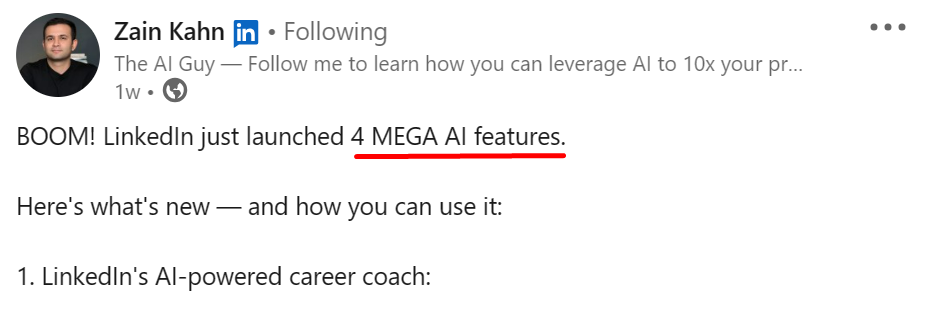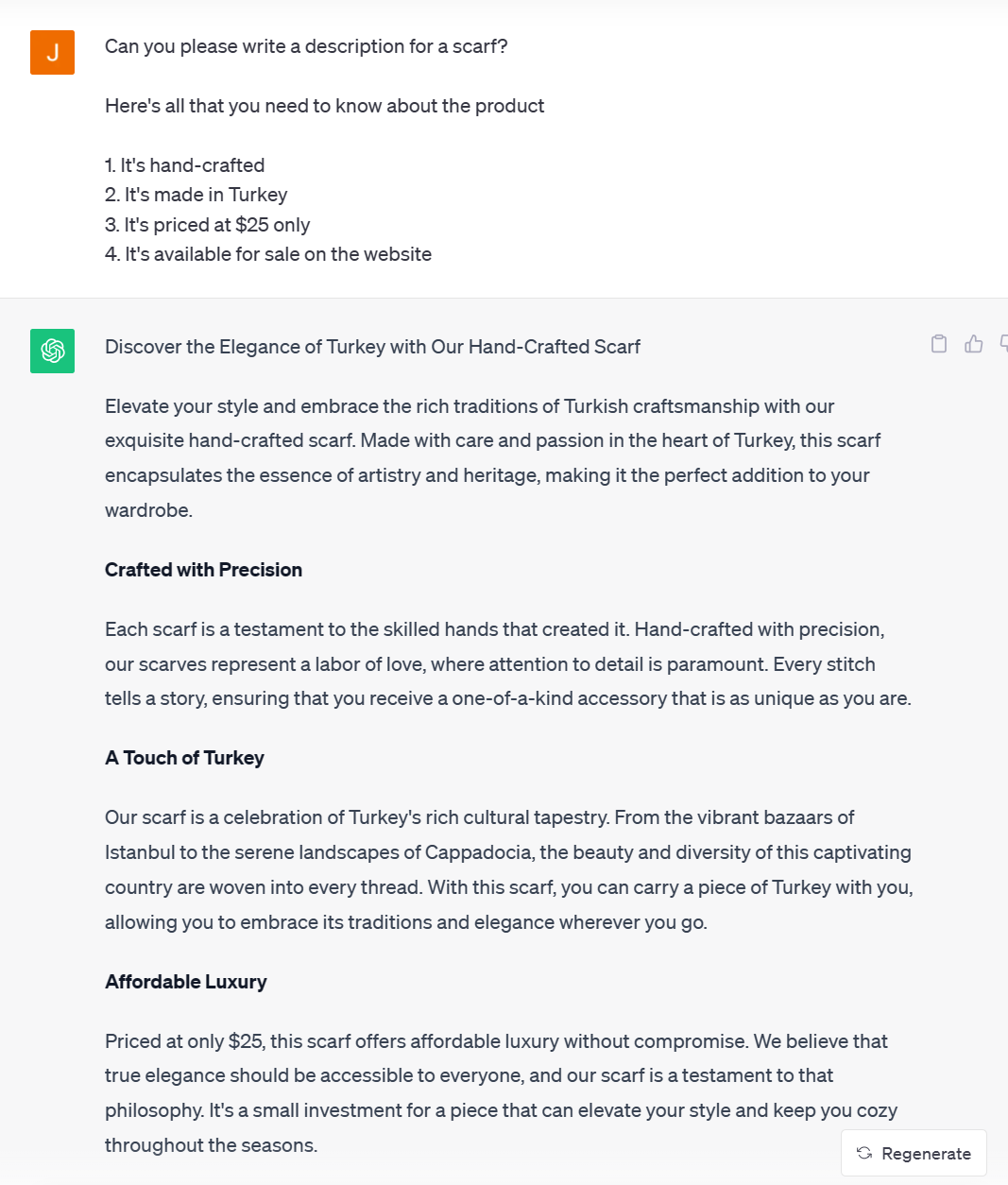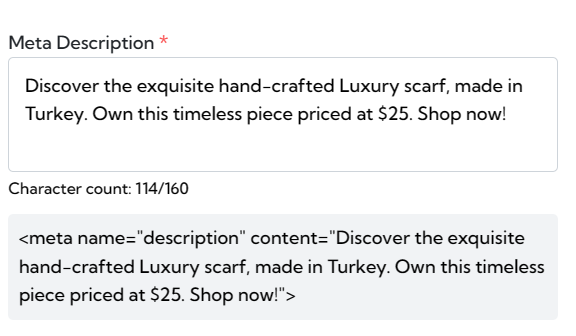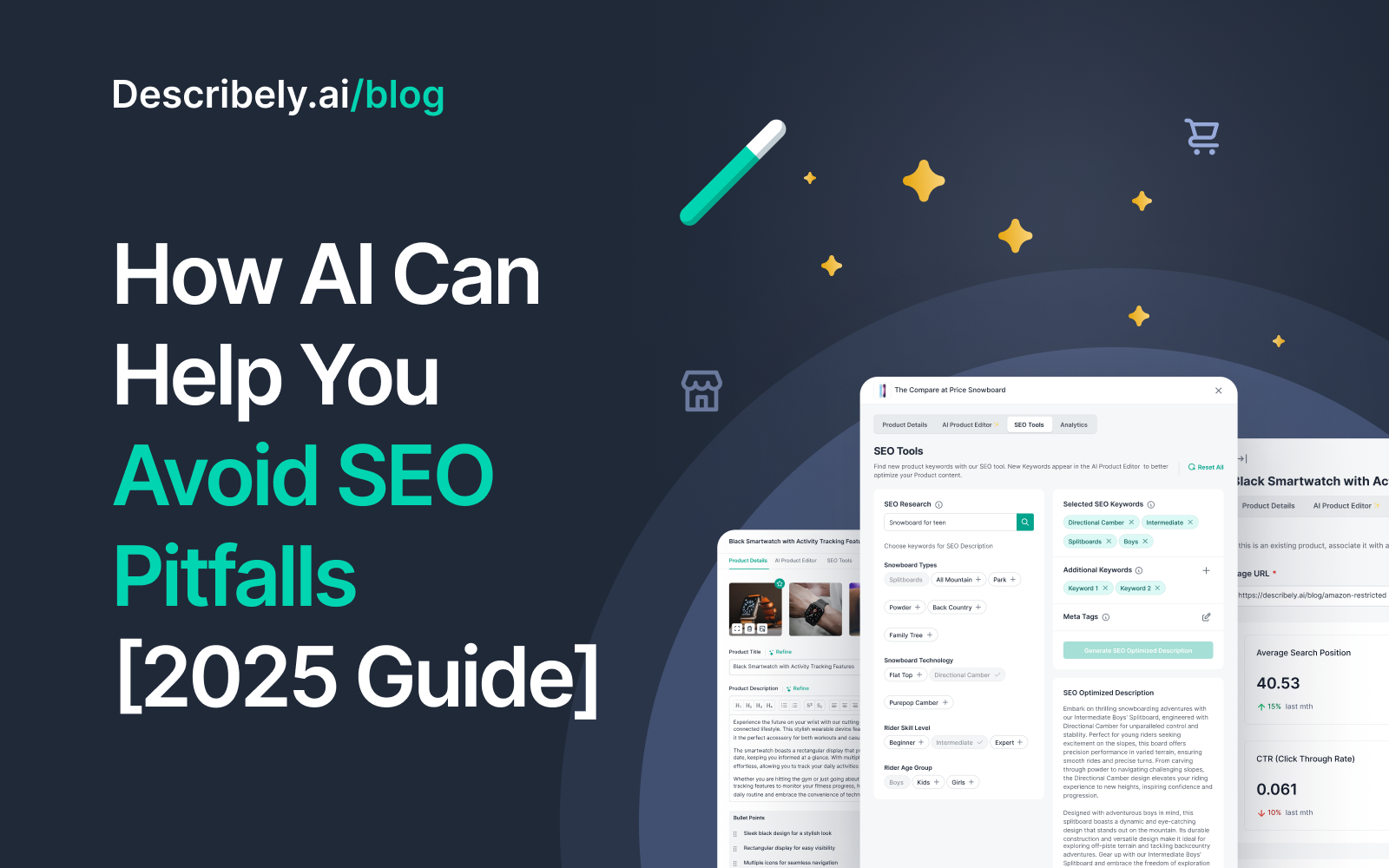
6 Practical AI Use Cases in eCommerce For Generating Product Content [With Examples]
If the conversations in the past year could be summed up with a buzzword, then that buzzword would be artificial intelligence (AI).
Almost every industry (e.g., marketing, HR, sales, IT, etc.) is talking about the use cases of AI for their specific niche. For example, just take a look at some of the conversations on LinkedIn.
Exhibit A:

Exhibit B:

And Exhibit C:

However, even with all these (beneficial) conversations around us, the use cases of artificial intelligence for e-commerce are not yet widely discussed, especially when we look at how AI can impact larger e-commerce retailers and big-box stores.
And as a company that mainly helps e-commerce brands, we thought the onus was on us to discuss the practical use cases of AI for e-commerce folks, especially around product content like descriptions, titles, and tags. So, that’s exactly what we’re covering in this article today!
[Side Note: If you’re already aware of the benefits AI e-commerce tools can provide, and you just want to test Describely’s capabilities, then feel free to skip this article and sign up here for free.]
Why use AI in eCommerce to generate product content?
Here are some of the biggest benefits eCommerce artificial intelligence tools provide (especially in the context of generating product content):
- They help you save time by generating content in a matter of seconds.
- They’re a more cost-friendly option (in comparison to a professional writer).
- They’re available 24/7, so you can write product descriptions, titles, and meta descriptions around the clock.
- You can afford to run multiple A/B tests with it, as copy options are available in a matter of seconds.
- They’re also great for drumming inspiration and providing writers with unique angles.
- They enable you to enrich product descriptions and promote value propositions if your supplier provides you with sparse product details.
- You get to quickly refresh outdated/stale product listings with more details and keywords (this is an important use case for larger e-commerce stores that regularly update entire product categories in bulk).
Certain e-commerce AI solutions that are specifically made for the e-commerce industry (such as Describely) also help brands maintain a level of consistency with tone and content style by allowing users to set custom rules.
Just for some context: Here are all the rules you can customize to ensure your content looks more “human” and matches your brand tone and style.

If we take things at a macro level and consider larger retailers looking to create/update all product listings with a single click (based on their preferred brand voice/custom AI rule set), then there’s good news there as well —– they can do so with the help of Describely’s “Business Hub.”

Moreover, solutions like Describely will also help you generate and edit content in bulk, integrate with store connectors, and optimize your descriptions with SEO keywords —- to put it simply, if you run an eCommerce store, it’ll become your best friend.
What’s the secret to using AI in eCommerce to generate perfect product copy?
The thing with generative AI tools, such as Describely, ChatGPT, and others, is that they’re only as good as the data you feed it.
For example, if you only feed AI tools information about The Office and ask them to write an Avengers-style movie script, they’re probably not going to churn out the best possible content. The same goes for product copy too.
So, the secret to creating the perfect product descriptions is to not use tools that are generic (such as ChatGPT), but rather use AI solutions for e-commerce that were trained using e-commerce data (such as Describely).
While this might sound like some level of bias on our side, let’s quash these doubts by doing a simple experiment and feeding both ChatGPT and Describely the same prompts (for the sake of this experiment, we’ve not set any custom rules on Describely).
The results are as follows:
ChatGPT just uses the same points you feed it. For example, if you tell ChatGPT a product is hand-crafted, it rewrites “crafted with precision,” and if you tell it the product is made in Turkey, it rewrites that to “a touch of Turkey.”
And while the content itself isn’t too bad, it does have some obvious issues vis-a-vis:
- Structure (the content it produces is structured more like a blog and less like a description); and
- Scalability (can you sit and rewrite your entire product catalog on ChatGPT?)

Describely, on the other hand, produces descriptions that look something like this:

While it does address the major issues ChatGPT has, such as structure (descriptions look like descriptions, as opposed to looking like blogs) and scalability (you can import your entire store catalog), it also goes above and beyond to ensure your products are easily findable by making them SEO-optimized.
Now that the experiment’s done, let’s look at the specific use cases of artificial intelligence in eCommerce.
AI in eCommerce examples, use cases, and more
1. Use AI to generate product descriptions
If you wish to generate product descriptions, especially at a large scale, while maintaining consistency with brand tone and style, then e-commerce artificial intelligence (AI) tools are exactly what you need.
Consider the possibility of having a product catalog with 100 different products and ten variations (e.g., color or size) for each product, then AI can make those small tweaks for each individual variant.
Or, if you offer products to five different countries with five different local languages, AI can be especially useful in those situations.
Or, even if you’ve got a ready-made product description, but you just want to update it with certain terms and keywords, then that’s another area where AI can help you.
If you find yourself in the last situation, you can simply go to the “SEO Tools” tab in Describely, write your product name/theme, and the most search-friendly keywords will pop up (e.g., typing “luxury scarf” brings up all these keywords).

You can also conduct SEO research on your own and ask tools like ChatGPT to integrate those keywords in your text.
Just a word of advice: The descriptions these AI tools produce will only be as good as the prompts you feed them, so we’d recommend providing your tools enough information about your products and/or training them about your brand’s tone and voice. If you have a larger store, consider using Desribely’s Business Hub.
You can even use this resource to learn how to create better prompts that also allow you to save time: 30+ Time-Saving ChatGPT Prompts for Writing Better E-commerce Product Content.
2. Use AI to generate product titles
Another thing AI can be particularly helpful for? Generating product titles.
To make these titles hyper-relevant for your business, we’d recommend setting custom rules so the AI can mold the titles according to your preferred character length, tone, and language.
For reference, here’s an example of us setting custom rules on Describely to ensure the content it produces matches the tone/style we’re looking for.

You can feed other AI tools (like ChatGPT) the same information. For example:

The major benefit of AI tools in this situation is you can ask it to produce multiple titles at once and can A/B test different titles, character lengths, keywords, tones, etc., to see what works for your audience and what doesn’t.
If the feature’s available, we’d also recommend feeding AI tools information about your audience’s pain points so the titles are relevant based on user intent.
[Writer’s Note: Just a quick FYI if you stick with solutions like ChatGPT, one downside you’ll have to prepare for is having to navigate all your prompts and their subsequent answers manually, and individually copy-pasting all the answers it generates back into your store.
This may be fine if you’re dealing with a few standalone products but will be a difficult task if you’re dealing with entire product catalogs.]
3. Use AI to generate meta-descriptions
Meta descriptions are something most folks use AI for — and that’s mainly because it’s a low-risk task in the grand scheme of content production.
Same as before, to create them, customize your instructions. For example, here’s what your instructions can look like in Describely: 
Ideally, keep your meta descriptions under 160 characters and try to integrate your primary keywords within them to ensure your products are easily searchable online. Also, ensure your meta-descriptions have specific content, as opposed to vague statements.
You can even ask these AI tools for HTML metadata. For example, on Describely, the metadata is available directly under the meta descriptions:

But on tools like ChatGPT, you’ll need to specifically ask for this data:

4. Use AI to save time generating tags
The thing about working with a large product library is that oftentimes you’re tasked with finding products simply through keywords or tags —- and that’s another area where AI eCommerce technologies can be useful.
That’s to say, AI tools like Describely will not only create your product descriptions but will also automatically attribute these descriptions with the necessary tags.
Case in point:

[Writer’s Note: Many of our competitors, such as Jasper, Writesonic, ShopifyMagic, and Copy.ai, don’t typically offer the option to generate meta titles, meta descriptions, and product tags as they’re not catered towards the eCommerce industry.
So, you might benefit from sticking with a generic solution like ChatGPT that can churn out decent answers with some effort, or you can switch to solutions like Describely that are specifically designed for eCommerce customers.
Keeping metadata and tags aside, if you’re wondering how we differentiate ourselves from our competitors simply through product descriptions alone, this guide may be of help: Best Product Description Generators Tested (hint: all of them have been fed the same prompt!)]
5. Use AI to generate, edit, enrich, and refresh product copy in bulk
AI e-commerce tools such as Describely also offer the option to generate and edit content in bulk. And, in the likely scenario you have thousands of products in your catalog, you will need this feature on hand.
So, here’s what you need to do if you wish to generate and/or edit content in bulk:
- Go to your product catalog in Describely and select all the products you want to generate content for.
- Once selected, go to “Bulk Actions” and set custom rules after selecting “AI rules.”

- Post that, click on “Bulk Generate” —- and ta-da, you’re all done!

This process is unique to Describely because it allows you to set rules at once and then leave the task to AI to generate content in bulk. However, if you were to use other technologies, like Jasper, for example, you’d have to provide individual prompts to be able to create content.
The same goes for other AI tools like ChatGPT as well!
6. Use AI to remove background images from products
Last but not least, AI is also a powerful tool when it comes to removing unwanted background images or altering images. For example, consider the possibility that you missed a small item in the background of your images during a photoshoot —- AI can remove that for you!
While professional photographers might charge you anywhere between $2.5 to $30 per photo for editing services, AI can bring the cost down to pennies (if you use a paid service, that is). Additionally, the time it takes a human vs. a machine to get a job done is another debate.
And if you have larger product catalogs, that loss in time and money can eventually add up.
At Describely, we completely understand how frustrating such small oversights can be, which is why we’re working on beta tests of an AI Image Editor tool (you can now sign up for that too).
However, in the meantime, you can use other solutions like Adobe and Canva..
Here’s the link to Adobe’s page: Free Image Background Remover (you can even add other graphics to the background with this solution!)
And here’s the guide by Canva: How to Remove the Background From Images.
Leverage AI in eCommerce for better scalability
Let’s be real for a moment: If you’ve stuck around to the end of this article, one thing’s clear —- you’re desperately looking for ways to leverage AI in your eCommerce business.
It’s also possible you might be contemplating between different AI solutions in the market, so here’s a little input from our end that will help you form a verdict: If you’re in any other industry but eCommerce, you might benefit from other AI tools, but if you’re specifically looking for eCommerce AI then Describely is what you need.
It’s geared toward your business needs, and it’s going to present the results you need. In fact, just take a look at what Helen Valentine, the Online Web Production Lead at Target Australia, has to say about our software:
“Describely has been a game-changer for our organization. It’s saved us significant time and effort in generating descriptions and metadata, while also providing the flexibility and ease of use that we require. What sets Describely apart is its flexibility in adjusting the AI rules to suit our specific departments. The customizations allow us to generate more accurate descriptions, eliminating the need for constant adjustments and fine-tuning.”
And if you’re still contemplating, then we’d suggest signing up for Describely for free and trying it out yourself!



